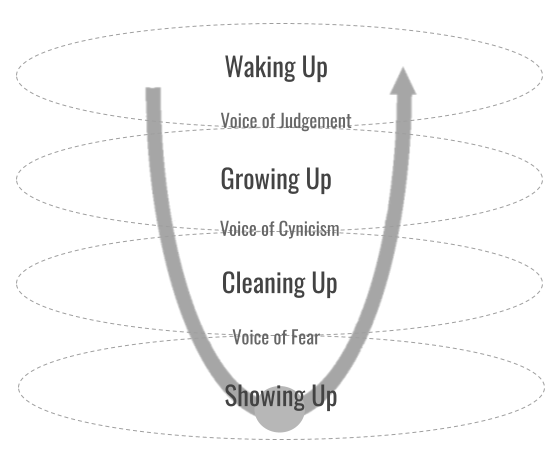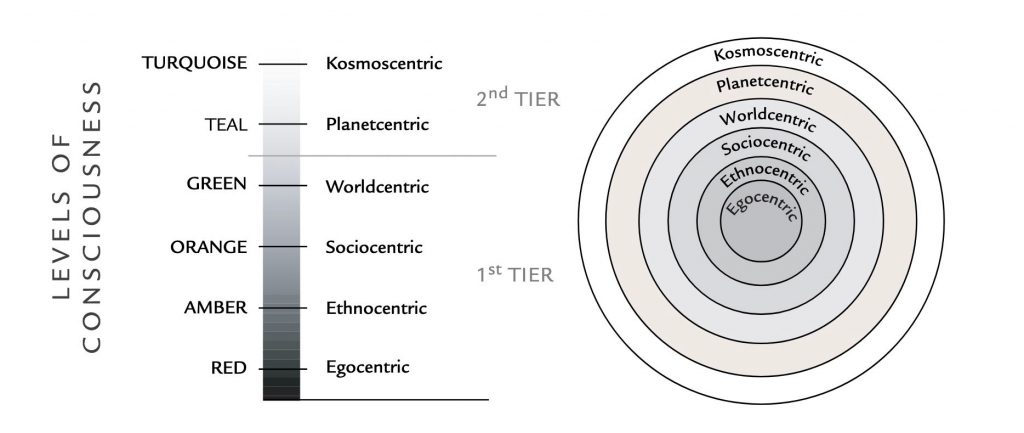Integral Map
The integral approach refers to a world view that aims to capture as many aspects of life and consciousness as possible and to depict this complex reality on a map. Only with this map do we get the necessary overview of the aspects involved in the complex reality of individuals, groups and organizations. The Integral Map reveals the ways to initiate successful development and transformation at all levels.
Holding Space
Holding space is a conscious act of being present, open, allowing, and protective of what another needs in each moment. It’s a broadly used phrase to define the act of „being there“ for another. To embrace another in acceptance is an act of compassion in and of itself. Holding space is something that seems simple, but actually takes a lot of practice and involves self and aftercare for the person holding space. When people feel that they are held in a deeper way that they are used to, they feel safe enough to allow complex emotions to surface that might normally hidden. To truly support people in their own growth, transformation, grief, etc. we can’t do it by taking away or trying to fix the problems. Holding space is a complex practice that evolves as we practice it, and it is unique to each person and each situation.
Deep Listening
Deep Listening is a way of hearing in which we are fully present with what is happening in the moment without trying to control it or judge it. It means listening to the spoken and the unspoken, to the voice of reason, as well as the voice of emotion. Deep listening is when the mind is open, curious and interested. It is a practice of presence that involve all three of our centers of intelligence: Head, Heart and Hara. The four levels of listening refer to the place of our attention.
Level 1 – Downloading: I listen in order to confirm what I already know. I project my reality on to the world.
Level 2 – Factual Listening: I listen from the outside. Becoming aware of differences – data that contradicts my worldview or theory.
Level 3 – Empathic Listening: I listen from the place of communication. I take the footsteps of someone else, allow for emotional connection.
Level 4 – Generative Listening: I connect myself with the highest potential of the system and myself.
Generative Dialogue
Communicating with one another comes in various forms. Sometimes we communicate to express our opinion, convey information, or to signify how we are feeling. As well, there tends to be a persuasive aspect to much of our communication in that we use words and images to “sell” our ideas, values, and opinions.
Generative Dialogue is an expansion of Bohmian Dialogue, discovered by quantum physicist, Dr. David Bohm. Bohm believed Dialogue to be a process of ‘thinking together’ in the course of which a valuable form of relationship of trust can emerge. Bohm’s model of Dialogue is centered on shared meaning and mutual understanding and his belief that Dialogue can help us to understand the “often incoherent ways in which we think, helping us to address the root causes of a range of contemporary problems”.
Generative Dialogue means to form a space of deep attention that allows an emerging future possibility to „land“ or manifest as well as a future self showing up. A realm of collective creativity, speaking from what is moving through.
Evolving with Integral & Presencing

Waking Up – get present, mindful and alive with the most powerful understanding of spiritual growth available.
Growing Up – learn to take and see new perspectives that broaden your mindset.
Cleaning Up – do the emotional housecleaning that settles your fears for good and unleashes your real power.
Showing Up – apply yourself to what you want the world to become, with new capabilities to listen, teach, persuade and lead.
Growing Up and Waking Up –
the two sides of personal growth
The process of development through knowledge of psychology of the West is called growing up. The experience of what one has on the Eastern meditative traditions is called waking up.Atruly encompassing integral approach has to have at least these two major factors of human development included. Psychology has been blind to that, before Jung, the transpersonal psychology and integral psychology has brought in the subject. In Integral Theory we have stages of personality development and spiritual state-stages together finally, for the first time integrated.
Psychological development starts before birth as perinatal psychology, a stage we call Level 0. It continues after the physical birth and from age 0 to 1 we have Level 1, also called Physical Self. Followed by the mother-child relationship on Level 2 (Emotional Self) between ages 1 to 3, the psychodynamic playful and stormy, pre-operational Level 3 (Egocentric Self) between ages 3 to 7 years old. Then when the mental control wins over the impulsive self, 4th stage emerges, the concrete operational rule-role mind between ages 6 to 12 (Role Self); followed by the formal operational Achiever Self from age 12. That brings an independent rational thinking. From this point on development is not strictly age bound. Still experience shows that for a genuine post-conventional, post-modern, Emphatic Self we need some adult maturity. We earliest suggest it’s arising in the mid 20es, or even later. Even further development are the Integral Self and higher stages. Another way to describe development is the increasing capacity of perspective taking that goes with increasing empathy and social skills, from the early egocentric stage to the late cosmocentric one.

Depending on our experiences during the formative years, the time we reach our late 20s, we either move naturally and easily into the Empathic Self stage of our development (post-modern, worldcentic stage) or we spend a good part of the rest of our life, if not all of our life, trying to find ways to master our deficiency needs, our unmet basic needs. Most educated people, brought up in democratic societies, lie somewhere between these two extremes. They are able to satisfy most of their deficiency needs but find it a struggle to move through the Empathic Self and Integral Self stages.
If you are reading this article, you are most likely one of these people. Your parents and the culture you were brought up in probably did a reasonably good job in helping you to satisfy your basic needs, but not good enough to allow you to sail smoothly through the Empathic Self and Integral Self stages. You are more than likely to have learned some limiting beliefs when you were a toddler, a child or a teenager about not being able to meet your basic needs – not having enough, not being loved enough or not being good enough.
Vertical and Horizontal Development
Vertical Development is the transformation of how a person thinks, feels, and makes sense of the world. It includes the development of both mental complexity and emotional intelligence. While vertical development focuses on the how, horizontal developing targets what a person knows. Horizontal development represents the knowledge and skills we acquire while operating at the same level of cognitive, emotional, and relational complexity. Vertical development broadens our views and permanently heightens our awareness, making us both wiser and more caring.
Vertical Developement = Mindset Transformation
– Improves how we think and how we interpret any situation.
–
Essential to address complex problems, cultivate high-stakes
relationships, and navigate rapidly changing, uncertain circumstances.
–
Develops our mental complexity and emotional intelligence, literally
upgrading our leadership operating system to be more wise and caring.
Horizontal Development I = Competence Development
– Increases what we know and strengthens technical expertise.
– Essential for using known techniques to solve clearly defined problems.
– Develops functional knowledge, skills, and behaviors that strengthen our leadership toolkit.
Horizontal development II = Expansion of Consciousness
– Expansion and refinement of perception from gross to subtle to very subtle (conscious, preconscious, unconscious, subconscious, superconscious).
– Exercises with the physical, emotional and causal body.
– Walking through the dark night of the senses, the soul and the self.
Shadow Work
Shadow Work is a personal growth process which brings your hidden power out of the shadow and into light. The term „shadow“ was first used by Carl Gustav Jung to describe the repressed or denied part of our Self. Our shadows are all those parts we have split off, repressed or denied – the part of ourselves we are afraid to show. You can identify your shadow by looking at what you project onto others. You can also notice the traits which you admire the most in others. I believe that the core of every shadow contains a nugget of strength and power. In an atmosphere of complete privacy and safety, you will find yourself easily accessing very deep states of emotions, resolution, inspiration and creativity.